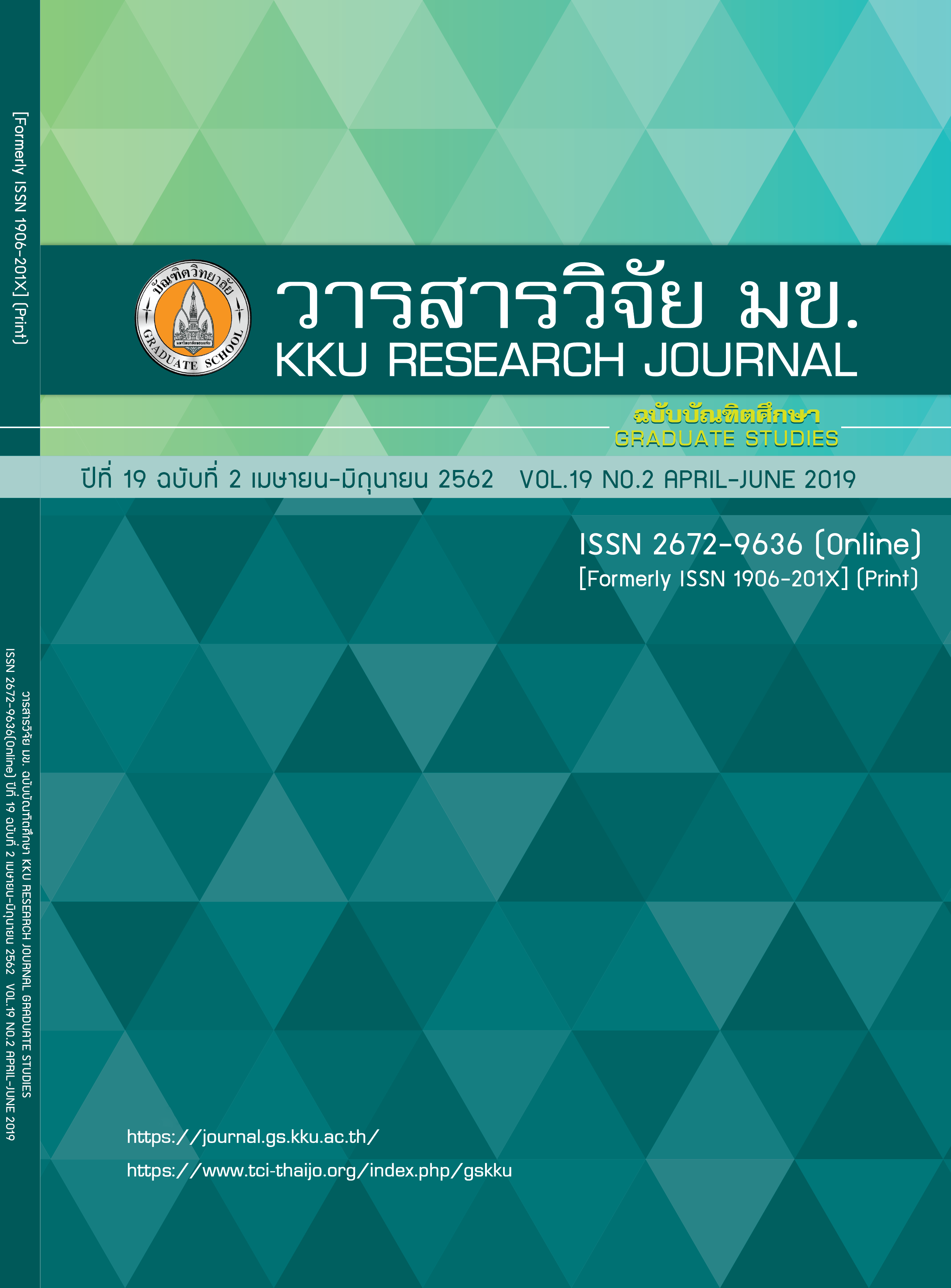A Study on Sustainability Indicators in Development of Urban Infrastructure Project Using Analytic Hierarchy Process: A Case Study of Chiang Mai Municipality
Keywords:
Sustainability indicators, Urban infrastructure project, Analytic Hierarchy Process (AHP)Abstract
The purpose of this research was to identify and prioritize sustainability indicators for urban infrastructure project using Analytic Hierarchy Process (AHP). The Chiang Mai municipality was chosen as a case study. Data was collected using purposive sampling by interviewing people who live in the Chiang Mai municipality area and have knowledge in urban infrastructure development. Analytical Hierarchy Process technique was employed to analyze data. The results of this study reveal the sustainability indicators were categorized in three hierarchy structure levels; three main criteria, eleven sub-criteria, and thirty-two indicators. The first seven most important sustainability indicators have different global importance weights from the next priorities, and their total global weight is more than 40% of the total, cover the three dimensions of sustainable development: economic, environmental, and social. The first most important sustainability indicator is “waste reuse and recycling”. The results of this study will be used as a key criterion in Decision Support System (DSS) for selecting sustainable urban infrastructure project alternatives.
References
2. Philipp R, Ricky B. Cities: investing in energy and resource efficiency. In: United Nations Environment Programme, corp. editors. Towards a green economy: pathways to sustainable development and poverty eradication. United Nations Environment Programme; 2011. p. 453-492.
3. UN Population Division. World urbanisation prospects: the 2014 revision. New York: UN, Department of Economic and Social Affairs; 2014.
4. Ugwu OO, Kumaraswamy MM, Wong A, Ng ST. Sustainability appraisal in infrastructure projects (SUSAIP): Part 1. Development of indicators and computational methods. Automation in Construction. 2006; 15(2): 239-51.
5. World Commission on Environment and Development (WCED). Our common future. Oxford: Oxford University Press; 1987.
6. Chen M-C, Ho T-P, Jan C-G. A System Dynamics model of sustainable urban development: assessing air purification policies at Taipei city. Asian Pacific Planning Review. 2006; 4(1): 29-52.
7. Nathan HSK, Sudhakara Reddy B. A conceptual framework for development of sustainable development indicators. Mumbai: Indira Gandhi Institute of Development Research; 2008 Mar. 47 p. Report No.: WP-2008-003.
8. Egilmez G, Tatari O. A dynamic modeling approach to highway sustainability: strategies to reduce overall impact. Transportation Research Part A: Policy and Practice. 2012; 46(7): 1086-96.
9. Mosadeghi R, Warnken J, Tomlinson R, Mirfenderesk H. Comparison of Fuzzy-AHP and AHP in a spatial multi-criteria decision making model for urban land-use planning. Computers, Environment and Urban Systems. 2015; 49(0): 54-65.
10. Awasthi A, Chauhan SS, Omrani H. Application of fuzzy TOPSIS in evaluating sustainable transportation systems. Expert Systems with Applications. 2011; 38(10): 12270-12280.
11. Fernández-Sánchez G, Rodríguez-López F. A methodology to identify sustainability indicators in construction project management-Application to infrastructure projects in Spain. Ecological Indicators. 2010; 10(6): 1193-1201.
12. Chiang Mai Province Governor Office. Annual report 2016 [Internet]. 2017 [updated 2017 Feb; cited 2018 Mar 18]. Available from: http://www.chiangmai.go.th/managing/public/D8/8D01Feb2017150134.pdf. Thai.
13. Saaty TL. The analytic hierarchy process. New York: McGraw-Hill; 1980.
14. Shiau T-A, Liu J-S. Developing an indicator system for local governments to evaluate transport sustainability strategies. Ecological Indicators. 2013; 34(0): 361-371.
15. Zhang Y, Sun Y, Qin J. Sustainable development of coal cities in Heilongjiang province based on AHP method. International Journal of Mining Science and Technology. 2012; 22(1): 133-137.
16. Aly S, Vrana I. Evaluating the knowledge, relevance and experience of expert decision makers utilizing the Fuzzy-AHP. Agricultural Economics – Czech. 2008; 54(11): 529-535.
17. Cheng EWL, Li H. Construction partnering process and associated critical success factors: quantitative investigation. Journal of Management in Engineering. 2002; 18(4): 194-202.
18. Lam K, Zhao X. An application of quality function deployment to improve the quality of teaching. International Journal of Quality & Reliability Management. 1998; 15(4): 389-413.
19. Wong JKW, Li H. Application of the Analytic Hierarchy Process (AHP) in multi-criteria analysis of the selection of intelligent building systems. Building and Environment. 2008; 43(1): 108-125.
20. Ugwu OO, Haupt TC. Key performance indicators and assessment methods for infrastructure sustainability—a South African construction industry perspective. Building and Environment. 2007; 42(2): 665-680.
21. Shen LY, Wu YZ, Zhang XL. Key assessment indicators for the sustainability of infrastructure projects. Journal of Construction Engineering and Management. 2011; 137(6): 441-451.
22. Sahely HR, Kennedy CA, Adams BJ. Developing sustainability criteria for urban infrastructure systems. Canadian Journal of Civil Engineering. 2005; 32(1): 72-85.
23. Yao H, Shen LY, Tan YT, Hao JL. Simulating the impacts of policy scenarios on the sustainability performance of infrastructure projects. Automation in Construction. 2011; 20(8): 1060-1069.
24. Lim SK. Framework and processes for enhancing sustainability deliverables in Australian road infrastructure projects [PhD thesis]. Queensland University of Technology; 2009.
25. Elbarkouky MMG. A Multi-Criteria Prioritization Framework (MCPF) to assess infrastructure sustainability objectives and prioritize damaged infrastructure assets in developing countries. Journal of Sustainable Development. 2012; 5(9): 1-13.
26. Danko CC, Lourenco JM, editors. A discussion on indicators and criteria for sustainable urban infrastructure development. Proceedings of the Workshop Sustainable Development Policies for Minor Deprived Urban Communities : COST Action C27; 2007; Évora, Portugal: COST European Cooperation; 2007.
27. Akinyemi EO, Zuidgeest MHP. Managing transportation infrastructure for sustainable development. Computer-Aided Civil and Infrastructure Engineering. 2002; 17(3): 148-161.



